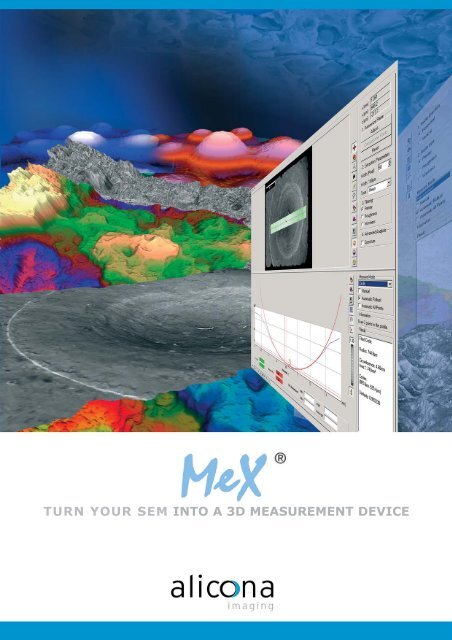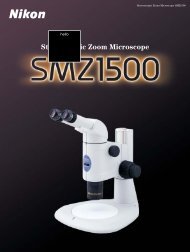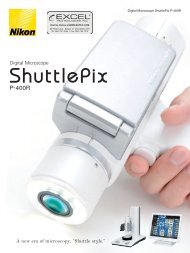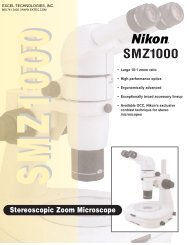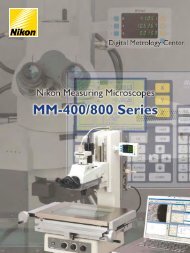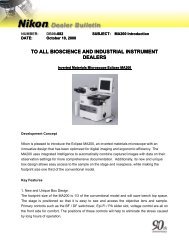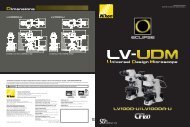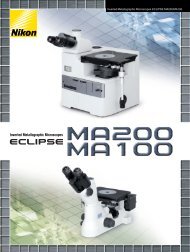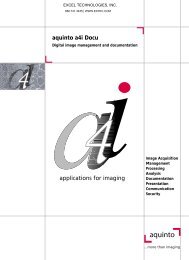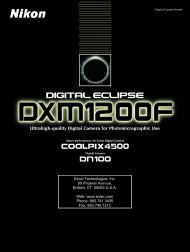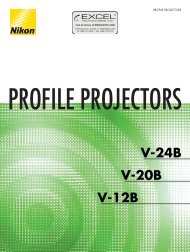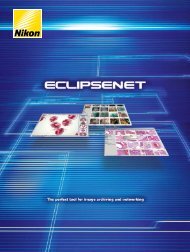MeX: Turn Your SEM into a 3D Measurement Device (.pdf)
MeX: Turn Your SEM into a 3D Measurement Device (.pdf)
MeX: Turn Your SEM into a 3D Measurement Device (.pdf)
Create successful ePaper yourself
Turn your PDF publications into a flip-book with our unique Google optimized e-Paper software.
TURN YOUR <strong>SEM</strong> INTO A <strong>3D</strong> MEASUREMENT DEVICE
<strong>3D</strong> SURFACE METROLOGY WITH THE <strong>SEM</strong><br />
<strong>MeX</strong> turns any <strong>SEM</strong> <strong>into</strong> a measurement device<br />
<strong>MeX</strong> is a stand alone software package that turns any <strong>SEM</strong><br />
with digital imaging <strong>into</strong> a true surface metrology device.<br />
Using stereoscopic images the software automatically<br />
retrieves <strong>3D</strong> information and presents a highly accurate,<br />
robust and dense <strong>3D</strong> dataset which is then used to perform<br />
traceable metrology examination. The results are obtained<br />
irrespective of the <strong>SEM</strong> magnification providing metrology<br />
at macro and micro levels.<br />
The software is self installing and is extremely easy to use.<br />
The modular design of the package allows flexibility in use;<br />
it also permits users, with a single repetitive task to perform,<br />
to purchase modules according to requirements. The analysis<br />
modules allow measurement of profile, roughness, area,<br />
volume and “Z” height. All measurements are traceable, can<br />
be calibrated and conform to ISO standards.<br />
The performance of <strong>MeX</strong> has been proved by many customers<br />
in leading companies and universities throughout the<br />
world providing imaging and analysis previously unobtainable<br />
with <strong>SEM</strong> images.
UNIQUE FEATURES ALLOW NEW APPLICATIONS<br />
Robust and highly accurate at any magnification<br />
The core of <strong>MeX</strong> is formed by its innovative <strong>3D</strong> reconstruction<br />
algorithms. The research and development<br />
team of Alicona Imaging have invented methods that<br />
generate highly accurate, dense and robust results.<br />
This unique performance becomes obvious in images<br />
of complex structures with steep edges and drop offs<br />
in addition to demanding samples with low texture and<br />
signal-to-noise-ratio. This high quality is achieved irrespective<br />
of image magnification.<br />
Automatic calibration allows traceable <strong>3D</strong> measurement<br />
Conventional approaches rely on the use of two images. This comes with the major drawback that the overall accuracy of the <strong>3D</strong><br />
measurement is partly dependent on the accurate reading of the tilt angle. It is also commonly known that this reading maybe<br />
error-prone and can only be achieved to a certain level<br />
of accuracy. Latest developments of Alicona have<br />
extended this stereoscopic approach to a third image.<br />
As a result the user defined parameters, such as the tilt<br />
angle, are automatically calculated. This omits the influence<br />
of the user and allows, for the first time, traceable<br />
<strong>3D</strong> measurement in the <strong>SEM</strong>.
Easy to use, easy to install<br />
No additional hardware is necessary to run <strong>MeX</strong>. As a pure software solution <strong>MeX</strong> can be operated<br />
with any <strong>SEM</strong> requiring only images in common formats. The software is self-installing and works completely<br />
independently of any third party drivers or components. The user interface of<br />
the overall package is very user friendly and self-explanatory. Data is obtained quickly<br />
and effectively. A wizard guides the user through the reconstruction process which<br />
then automatically converts the information to a <strong>3D</strong><br />
data set. The consecutive analysis is again<br />
intuitive and the user is not confronted with<br />
unnecessary functionality. The user finds<br />
exactly what is expected from a <strong>3D</strong><br />
metrology package.<br />
Comprehensive depth analysis<br />
The uniqueness of <strong>MeX</strong> is in its accuracy and robustness. But in order to perform appropriate measurements,<br />
beyond conventional visualization, analysis following international standards must be available. In <strong>MeX</strong>, the easy to<br />
use, roughness and area analysis are provided to EN/ISO standards.<br />
<strong>Measurement</strong>s are performed directly on the <strong>SEM</strong> image. Printing and<br />
exporting the actual representations of an image are a one-click operation.<br />
The visual link between the surface and the image enable precise<br />
and flexible measurements. Even volumetric analysis is conveniently<br />
feasible. Therefore <strong>MeX</strong> is the only software package that turns a <strong>SEM</strong><br />
<strong>into</strong> a true <strong>3D</strong> metrology device.
THE TECHNICAL PRINCIPLE OF MEX<br />
<strong>3D</strong> measurement based on stereo images<br />
The image formation process in the <strong>SEM</strong> is<br />
based on perspective projection. Similar to a<br />
conventional light microscope the three<br />
dimensional object is projected onto a two<br />
dimensional image plane and information<br />
about the third dimension is lost. Note, the<br />
large depth of focus in <strong>SEM</strong> provides full<br />
depth of focus images, but does not allow to<br />
measure depth. Only two dimensional measurements<br />
in the image plane are feasible.<br />
An eucentric tilting of the stage, meaning that<br />
the intersection of the primary electron beam<br />
with the specimen define the centre of tilting,<br />
yield a second image of the specimen observed<br />
form a different viewpoint. A so called<br />
stereoscopic image is generated. Overlay<br />
techniques such as red-green coloring provide<br />
anaglyph viewing and thus depth perception<br />
but again no quantitative analysis. The leading<br />
technology of Alicona now automatically<br />
identifies points in each of the images that<br />
belong to the same point on the specimen.<br />
From theses so called homologous points the<br />
true three dimensional coordinates of the<br />
observed point can be recovered. This<br />
demanding task is robustly solved for each<br />
pixel in each of the images and thus a dense<br />
<strong>3D</strong> model of the specimen is obtained. An<br />
additional third image captured from a third tilt<br />
position allows to automatically refine given<br />
calibration data. Thus traceable results are<br />
obtained.
AUTOMATIC CALIBRATION<br />
Verification of measurements through height step<br />
Micro- contour-artefact, calibrated by PTB<br />
Height measurements with the AutoCalibration can be verified using a micro-contour-artefact that<br />
is calibrated by the PTB (Physikalisch Technische Bundesanstalt, Braunschweig). The depth measurement<br />
standard from the PTB contains grooves of different depth (from 240nm to 50µm).<br />
• The unique AutoCalibration works fully automatically. Alicona is the only supplier able to<br />
offer this technology.<br />
• <strong>MeX</strong> is the only real metrology package that allows numerically accurate measurements<br />
independent on the magnification.<br />
• <strong>MeX</strong> allows extended analysis features such as ISO conform roughness analysis and<br />
extended form analysis.<br />
RECONSTRUCTIONS AND ANALYSIS IN THE <strong>SEM</strong><br />
<strong>Measurement</strong> results in comparison<br />
Input image, <strong>3D</strong> reconstruction and height measurement with the AutoCalibrator. The AutoCalibrator refines<br />
the calibration data and allows more accurate measurements.<br />
Angle refinement with AutoCalibration<br />
Verification of measurements through radius measurement<br />
PTB calibrated micro artefact with steep flanks, height steps and cylindrical elements.<br />
<strong>Measurement</strong>s of the pure software solution <strong>MeX</strong> can be verified using a micro-contour-artefact<br />
that is calibrated by the PTB (Physikalisch Technische Bundesanstalt, Braunschweig). The artefact<br />
contains different regions including steep flanks, height steps and cylindrical elements.<br />
The following measurements can be verified:<br />
• Circle measurements<br />
• Steep flanks<br />
• Depth measurements<br />
RECONSTRUCTIONS AND ANALYSIS IN THE <strong>SEM</strong><br />
Comparison of circle measurements<br />
Verification of circle measurements. One of the input images (<strong>SEM</strong>) obtained from the region with the cylindrical<br />
valleys. The radius of the circle was measured with <strong>MeX</strong> – AutoCalibration.<br />
Angle refinement with AutoCalibration
Volume Analysis<br />
Volume analysis calculates the volume of voids and protrusions. The measurement<br />
area is defined directly on the optical image. The volume is determined<br />
throughout the computation of a soap film model. For the <strong>3D</strong>boundary<br />
of the selected area <strong>MeX</strong> calculates a covering<br />
surface that behaves like a soap film.<br />
• Selectable area for volume measurement<br />
• Selectable reference surface (plane, minimum spanning surface, top<br />
and bottom cover)<br />
• Automatic calculation of reference<br />
plane from <strong>3D</strong> points<br />
2D Image Analysis<br />
2D image analysis allows the performance of manual and semi automatic<br />
measurement of simple primitives. Also, the ability to write on<br />
the images as well as saving measurement results in a comprehensive<br />
and easy to use database is provided.<br />
• Manual measurement of lines, parallel lines, arcs, circles, ellipses, polygons,<br />
polylines, freehand, marker<br />
• Automatic measurement of lines, parallel lines, circles, arcs<br />
• Statistical calculation of results such as mean,<br />
standard deviation, minimum, maximum, median<br />
• Automatic search of equally shaped structures on the image
PRACTICAL SOLUTIONS WITH MEX<br />
FRACTURE ANALYSIS<br />
Courtesy O. Kolednik, Austrian Academy of Sciences, Leoben/Austria<br />
STEEL PRODUCTION<br />
FORENSIC STUDIES<br />
CRATER SHAPE<br />
MEASUREMENT<br />
Courtesy A. Kearsley, Natural History Museum, London/UK<br />
CANCER RESEARCH IN<br />
LIFE SCIENCE<br />
Courtesy R. Anderson, University of Illinois, Chicago/USA
Quantitative surface analysis with the <strong>SEM</strong> is often used to investigate damage evolution in materials in addition to assisting in the design of more<br />
fracture resistant materials. The optimization of materials is complicated by the fact that the material properties may need to vary locally within the<br />
component. An example of this is cutting tools that need to be very hard at the cutting edge but be tough in the interior of the material. <strong>MeX</strong> is used<br />
to study deformation and fracture behaviour to optimize the performance of inhomogeneous materials. Dense, robust and accurate <strong>3D</strong> reconstructions<br />
are created to allow measurement of fracture surface profiles, roughness parameters and fractal dimensions.<br />
<strong>3D</strong> measurement results computed by <strong>MeX</strong> lead to significant understanding of parameters such as fracture toughness, crack growth and propagation<br />
or fracture resistance.<br />
Modern high-tech steel is one of today’s´ most important materials in all kinds of industries, transportation or medicine. The surface characteristics<br />
can relate to appearance, conductivity, corrosion resistance, wear or many other properties. <strong>MeX</strong> is an essential tool to assist with surface characterization<br />
for quality assurance and failure analysis. The <strong>3D</strong> measurement capabilities provide robust and accurate results on properties such as fracture<br />
and compression strength, notch bar impact value or creep strength.<br />
<strong>MeX</strong> is also used to evaluate faults in steel production. The overall quality of steel is dependent on the topography of the roller used in its production.<br />
As soon as the roller exhibits any kind of surface defects the surface of the steel will show dimples and inclusions. Using the measurement<br />
capabilities of <strong>MeX</strong> these faults can be analysed and the source of the defect traced.<br />
Every gun leaves distinctive marks and traces on the bullet cartridge and projectile, similar to fingerprints. These traces on a gun, found at a crime<br />
scene, can be instrumental to prove guilt of suspects. Conventional methods are based on the analysis of 2D images to identify which bullet has<br />
been fired from which weapon. However, the <strong>3D</strong> visualization and measurement of the firing pin and cartridge indentation is far more precise. It is<br />
here that <strong>MeX</strong> offers unique capabilities providing a highly accurate, dense and robust <strong>3D</strong> reconstruction with full depth of focus taken over a large<br />
field of view. Using <strong>MeX</strong> a user can, for example, measure the volume of a firing pin impression along with profile that can be related directly to the<br />
firing pin. This leads to a numerical evaluation independent from any subjective point of view, providing rapid and understandable analytical data for<br />
interpretation.<br />
<strong>MeX</strong> can be used for the measurement of diameters, depths, angles of slope and volumes of craters created by impact of mineral grains on metals.<br />
This is part of the calibration work that has been done to help interpret cometary dust impacts on the stardust spacecraft, which returned to earth<br />
recently, carrying the first comet samples ever collected.<br />
<strong>MeX</strong> has been used as a measurement tool to interpret the size, density and composition of particles responsible for making micrometre-scale craters.<br />
The ease of use of <strong>MeX</strong>, with its intuitive graphical interface, has enabled the quick and simple measurement of the required parameters. Data<br />
input and the range of easily interpreted reconstructions make <strong>MeX</strong> to a most suitable tool for quantified reconstruction of crater shapes from tilted<br />
stereo-pair electron micrographs.<br />
<strong>MeX</strong> turns any <strong>SEM</strong>, in biological and non biological applications, <strong>into</strong> a full <strong>3D</strong> measurement device.<br />
Until <strong>MeX</strong>, the biological user has had limited methods that could provide accurate and robust measurements of surface texture, volumes and area<br />
of bulky irregular samples. In recent research <strong>MeX</strong> has been used to characterise the topography of the extracelluar matrix (ECM) underlying colon<br />
cancer cells at various stages. Also, the enhanced visualization and roughness measurement capabilities of <strong>MeX</strong> has provided additional information,<br />
not previously available, about the cancers´ behaviour. These findings have implications not only for improving the general understanding how<br />
colon cancer and metastasizes grow, but, also lead to a better understanding of the role of the ECM topography in cancer.
Alicona Imaging GmbH<br />
Austria, Teslastraße 8<br />
A-8074 Grambach/Graz<br />
phone: +43 316 4000-700<br />
fax: +43 316 4000-711<br />
e-mail: info@alicona.com<br />
® alicona and <strong>MeX</strong> are registered trademarks, © Copyright by alicona


